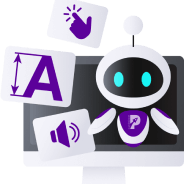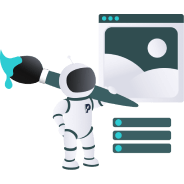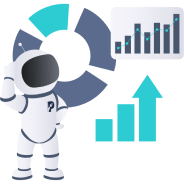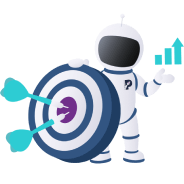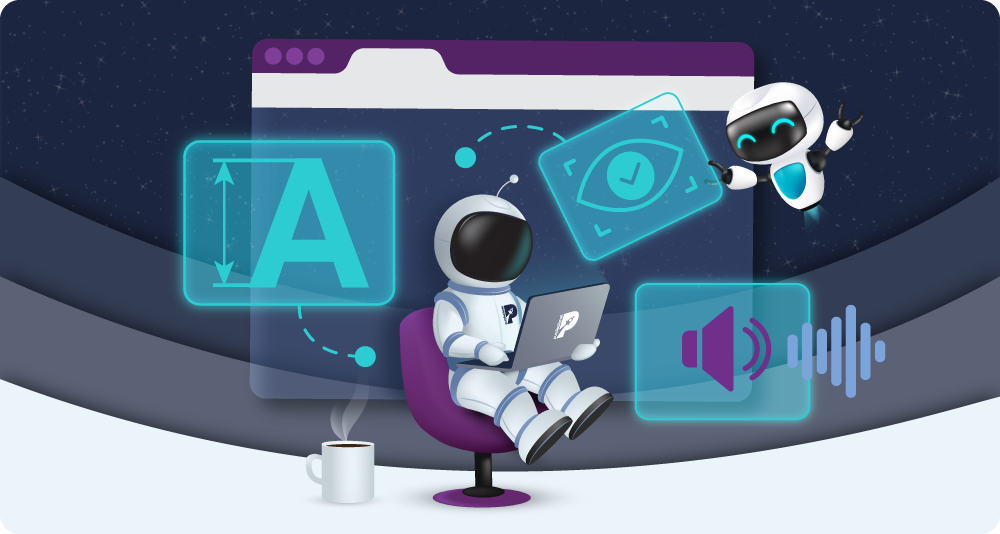

Web Accessibility: How to Create Inclusive and Accessible Digital Experiences for All Users
Key takeaways
-
Web accessibility is critical for ensuring that people with disabilities can access and use the internet.
-
Web accessibility is essential for providing equal access to information and services, promoting inclusion and diversity, and ensuring legal compliance.
-
Improving web accessibility starts with providing text alternatives for non-text content, ensuring keyboard accessibility, and using an appropriate colour contrast.
What is web accessibility?
The internet is an essential part of our lives, allowing us to connect, work, learn, and play in ways that were once unimaginable. Unfortunately, not everyone can fully enjoy the internet’s benefits due to web accessibility barriers.
According to the World Health Organisation, an estimated 15% of the world’s population lives with some form of disability, many of whom find it difficult or impossible to use websites.
So, what can be done about this issue? Enter web accessibility!
Web accessibility is the practice of designing and developing websites and web applications in a way that allows them to be used by everyone, including people with disabilities.
Optimising your website’s accessibility means that people with disabilities can navigate, understand, and interact with its content in ways that work for them. Specifically, it involves implementing certain changes that assist people with hearing, motor, visual, or cognitive impairments.
This article will provide an overview of web accessibility, including what you can do to adhere to the Web Content Accessibility Guidelines (WCAG). We will also discuss common web accessibility barriers and provide practical tips to help you create a more accessible website.
Why is web accessibility important?
Aside from the moral obligation to make websites accessible for all, there’s an important legal aspect that businesses need to consider:
Inaccessible websites can get into legal trouble due to the Equality Act 2010 in the UK, the Americans with Disabilities Act in the US, and accessibility laws and regulations in countries
worldwide. So, optimising your website’s accessibility is a good way to protect it from lawsuits and non-compliance claims.
Moreover, web accessibility simply makes good business sense. An accessible website can nurture a greater number of visitors and therefore increase engagement, user satisfaction, conversions, and more. This is especially true if your website wasn’t accessible before – just imagine the increase in people that will now be able to use your website!
Adapting elements of your website doesn’t have to be expensive. In fact, you can reclaim up to $5000 in tax relief if you’ve created an inclusive website in the US.
When thinking about optimising websites, SEO comes to mind – and it does apply to web accessibility. Thanks to search engines’ preference for accessible sites, your website’s reach will increase as you improve its accessibility.
Finally, web accessibility can be fast to implement. With our AI-driven service, purpleaccess, we can support your website’s changes with integrations in as quick as two minutes.
UK disability statistics
If a business’s website isn’t accessible, it’s seriously missing out on a large demographic. To put this in perspective, consider the following statistics:
- In 2021, 22% of the UK population had a disability.
- About 4.5% of the UK population are colour blind.
- More than 2 million people are living with sight loss in the UK.
- In the UK, one in five people have mild to severe hearing loss.
Web accessibility isn’t just for people with disabilities
Though accessibility elements are often built for people with disabilities in mind, they’re also used by people who are temporarily injured or in situations where full use of internet features is prohibited. For instance:
- Non-disabled users in quiet libraries might make use of captions (originally intended for people with hearing impairments) if they forget to bring their headphones.
- Non-disabled people may use keyboard navigation if they have a temporary hand strain that affects their ability to use a mouse (originally intended for people with motor impairments).
Remembering this is important because the number of users helped by improved web accessibility will be greater than you can ever know. Sure, we can know how many people in the UK have a hearing impairment, but we can’t know how many forget their headphones.
Therefore, we can be sure that optimising your website’s accessibility will have an unprecedented effect on user engagement. So, where do you start?
Understanding Web Content Accessibility Guidelines (WCAG)
For businesses to improve their websites’ accessibility level, they can follow the WCAG:
The Web Content Accessibility Guidelines (WCAG) were developed by the World Wide Web Consortium (W3C) to improve the accessibility of the World Wide Web for people with disabilities. These are the most widely used and accepted guidelines for web accessibility.
WCAG has three levels of compliance: A, AA, and AAA.
- Level A includes the most basic and essential requirements for web accessibility.
- Level AAA includes the most advanced and comprehensive requirements.
- Level AA is the recommended level of compliance, as it balances well between the basic and advanced requirements.
WCAG guidelines are categorised into four principles:
- Perceivable
- Operable
- Understandable
- Robust
These principles (sometimes called ‘POUR’) provide a framework for businesses wanting to create web content accessible to all users. Each principle includes specific guidelines and criteria that define the requirements for accessibility:
Perceivable
This principle requires that web content is presented in a way that can be perceived by all users, including those with sensory disabilities. This includes providing alternatives for non-text content, such as images and videos, and ensuring that text is readable and easy to understand.
Operable
This principle requires that web content is operable by all users, including those with physical disabilities. This includes providing keyboard navigation, clear and consistent navigation, and controls that are easy to operate.
Understandable
This principle requires that web content is understandable by all users, including those with cognitive disabilities. This includes using clear and simple language, providing instructions and feedback, and ensuring the content is predictable.
Robust
This principle requires that web content be robust enough to be interpreted by various devices, browsers, and User Agents such as assistive technologies. (For instance, ensuring the site’s markup language has complete start and end tags will help prevent display errors.)
Common Barriers to Web Accessibility
Many websites still have obstacles that make it difficult or impossible for people with disabilities to access their content. These must be identified if a website is going to successfully embark on a journey towards complete accessibility. Here are some of the most common barriers to web accessibility:
Lack of alternative text for non-text content
Alternative text (alt text) describes non-text content such as images, videos, and audio. Alt text is essential for people who are blind or visually impaired to understand the content. Without alt text, they may miss important information or be unable to navigate the website and leave as a result.
Inaccessible forms
Forms are a common feature of websites, but they can pose a significant barrier to accessibility if they are not designed correctly.
For example, if the form fields are not labelled correctly, users with screen readers may be unable to complete them. Similarly, if the form requires users to use a mouse, users who rely on a keyboard or other assistive technology may be unable to complete it.
Poor colour contrast
Colour contrast is essential for people with low vision or colour blindness to read and understand the content. If the colour contrast is poor, the text may be unreadable, and the content may be difficult to navigate.
Inaccessible multimedia
Multimedia, such as videos and audio, can be challenging for people with disabilities to access if they are not designed correctly.
For example, if the videos do not have captions or transcripts, people who are deaf or hard of hearing may be unable to access the content. Additionally, people who are blind or partially
sighted will need how-to videos to be audibly described – not just visually demonstrated.
Inaccessible navigation
Navigation is a critical aspect of website design. If it’s not clear or consistent, users may have difficulty finding or reading the content they need. Similarly, if the navigation is not keyboard accessible, users who rely on a keyboard or assistive technologies may be unable to navigate the website in the way that they want to.
How can you make your website accessible?
Is your website guilty of having any of the accessibility barriers above?
If so, it’s time to make some changes. Here’s how you can adapt your website to make it more accessible:
Tips for creating accessible websites
Use clear and simple language
Using clear and simple language is essential for making web content understandable for all users, including those with cognitive disabilities. Avoid using jargon or technical terms that may be difficult to understand.
Provide alternative text for non-text content
As mentioned earlier, providing alternative text for non-text content such as images, videos, and audio is critical for making web content accessible to people who are blind or visually impaired. This may include audible voiceovers alongside how-to videos, or captions that can be picked up by screen readers.
Allow for font adaptations
Some users might need to enlarge fonts if they’re visually impaired, as they might struggle to read small text. It’s great if you could offer an alternative style sheet that allows users to enlarge fonts without breaking the layouts of your web pages. This applies to all text – CTAs, important company information, or promotional content.
Ensure colour contrast is sufficient
Sufficient (high) colour contrast between text and backgrounds is essential for making content readable for people with visual impairments or colour blindness. Thin fonts may also pose problems, so opt for boldness and depth of colour.
Use descriptive link text and URLs
Using descriptive anchor text that accurately describes the content that the link leads to is essential for making web content understandable for all users, including those who rely on screen readers. This also applies to URLs, which can be problematic if vague. For instance:
Low readability: www.example.co.uk/join-us
High readability: www.example.co.uk/work-for-us
Provide captions and transcripts for multimedia content
Providing captions and transcripts for multimedia content such as videos and audio files is critical for making the content accessible to people who are deaf or hard of hearing.
Make navigation accessible
Provide clear and consistent navigation and ensure it’s keyboard-accessible and compatible with assistive technologies. You’ll need to consider all the interactive elements of your site, including:
- CTAs
- URLs
- Anchor text
- Forms
- Dialogue boxes
- Drop-down menus
- Widgets and icons
Use accessible web design and development practices
Using accessible web design and development practices, such as using semantic HTML and correctly structured content, is essential for making web content accessible to people who rely on assistive technology.
For instance, placeholder text poses a significant problem for visually impaired users wanting to complete online forms. This is because placeholder text can often be grey (low contrast) and skipped over by screen readers (since it’s non-label text). Web design decisions like these can cause a user to bounce off your site – so they’re crucial to consider.
These are just a few examples of the many best practices for creating accessible websites. To learn more about the WCAG, read this extensive checklist.
purpleaccess
If you’d like to develop your website’s accessibility and ensure it’s empowering all your users, you’ll love our new purpleaccess service.
Here at purpleplanet, we offer a range of digital services. Our new AI-led accessibility service is designed to help your website be scalable while empowering every user that visits your pages.
If you get on board with purpleaccess, you and your customers can expect the following accessibility features:
- Website inspection
- VPAT standards review
- Media accessibility
- File accessibility
- Back-end audit
- Usability testing
We’ll also help you cater to everyone visiting your site with our customisable accessibility interface. Users can choose between profiles that each offer adjustments to specific needs. For instance:
- Allow users to adjust font sizes, colour contrasts, and text handling so that on-screen elements are easier to read, whatever impairments they may have.
- Offer dictionary definitions for challenging words or phrases through search engine integration.
- Give users the choice of disabling audio, video, moving, and other distracting elements.
- Allow users to highlight important site elements so they can focus on specific parts of your website’s content.

